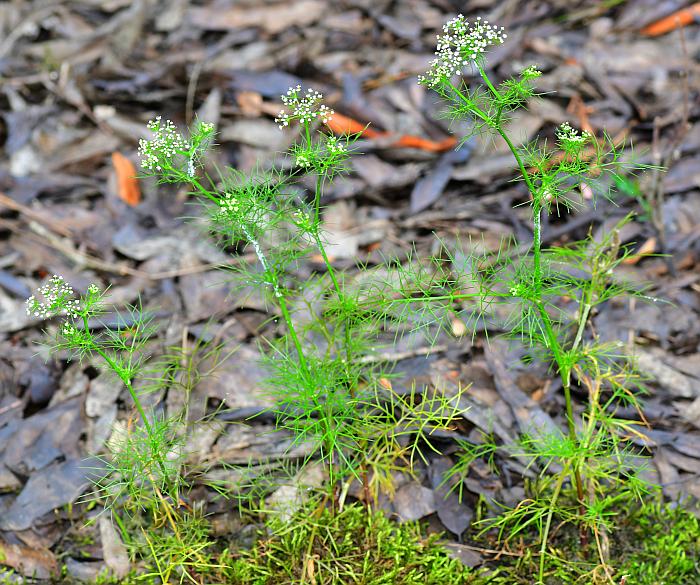Ptilimnium capillaceum (Michx.) Raf.
Atlantic Mock Bishop's Weed, Herbwilliam

Native
CC = 10
CW = -5
MOC = 6
© SRTurner
Ptilimnium capillaceum (Michx.) Raf.Atlantic Mock Bishop's Weed, Herbwilliam | |
 |
Native CC = 10 CW = -5 MOC = 6 |
© SRTurner |
|
Family - Apiaceae Habit - Annual forb, glabrous, from fibrous roots.
Stems - Ascending to erect, to 80 cm, often longitudinally striped.
Leaves - Alternate, compound, short-petiolate or sessile, the sheathing bases only slightly inflated. Leaf blades 4-12 cm long, narrowly ovate to oblong-ovate in outline, pinnately 2-3 times dissected, the main segments opposite or in whorls of 3 along the rachis, the ultimate divisions narrowly linear and threadlike, 3-25 mm long.
Inflorescences - Terminal and axillary compound umbels. Involucre of 2-9 bracts, these 4-12 mm long, mostly divided from near the base into 3 threadlike segments. Rays 4-20, 1.0-3.5 cm long. Flowers 5-20 in each umbellet, the stalks 3-6 mm long. Involucel of 2-5 bractlets, these mostly shorter than the flower stalks, linear.
Flowers - Sepals minute, broadly triangular scales. Petals obovate, often appearing shallowly notched, but narrowed or tapered abruptly to a short, slender tip, white. Ovaries glabrous. Styles at fruiting 0.2-0.5 mm long, loosely ascending.
Fruits - Schizocarps 1.5-3.0 mm long, with relatively broad, conspicuous, straw-colored to light yellowish brown surfaces between the lateral ribs and the commissures, the ribs similarly colored, the areas between the ribs with reddish brown oil tubes.
Flowering - June - August. Habitat - Bottomland forests, swamps, fencerows, railroads. Origin - Native to the U.S. Lookalikes - Other species of Ptilimnium. More broadly, many white-flowered members of the Apiaceae. Other info. - Even when fully in flower, this plant is visually inconspicuous and easily overlooked. The flowers are tiny; the leaves are frilly and highly dissected, and the entire plant generally stands only a half meter or so high, easily becoming lost amongst tall grass and other vegetation. The species is uncommon in Missouri, reported from only four southeastern counties (introduced farther north). Its natural range is almost entirely to our south and east. The plant resembles several other members of the family, but is easily distinguished with attention to detail. In particular, the leaves are highly dissected, with threadlike ultimate segments, and each involucral bract is divided into three segments (see diagram above). The flowers are tiny and white, and the ovaries and fruits glabrous. Photographs taken in the Croatan National Forest, NC., 7-18-02 (DETenaglia); also at Big Cane Conservation Area, Butler County, MO, 6-9-2023 (SRTurner). |